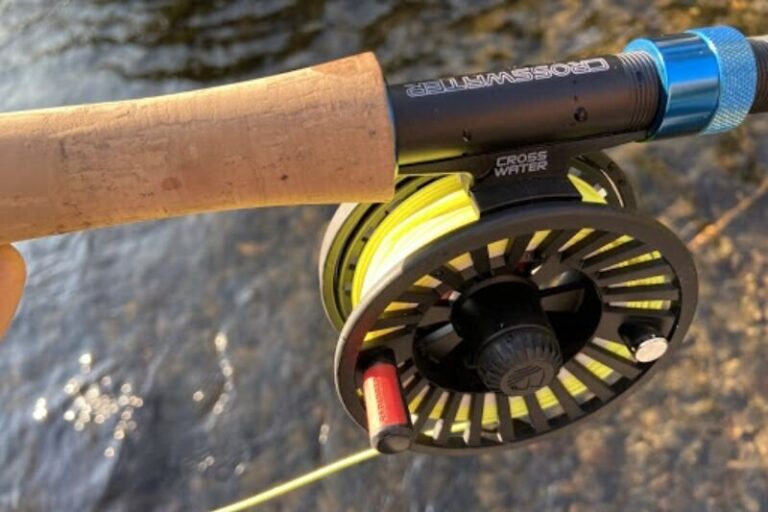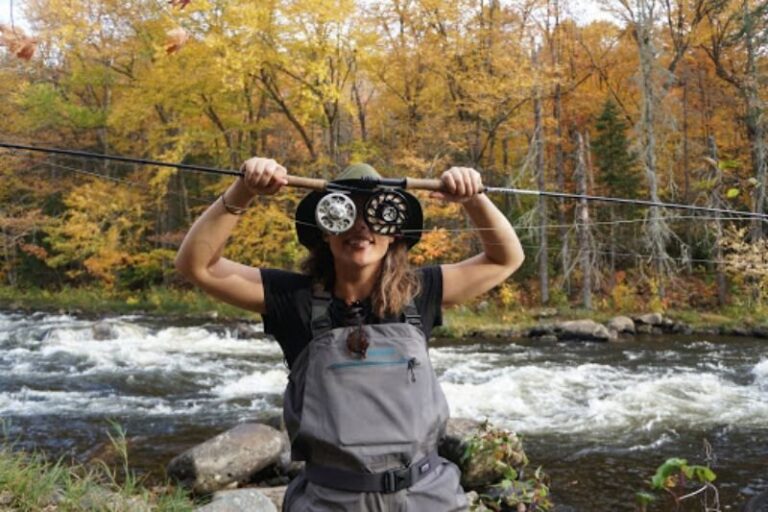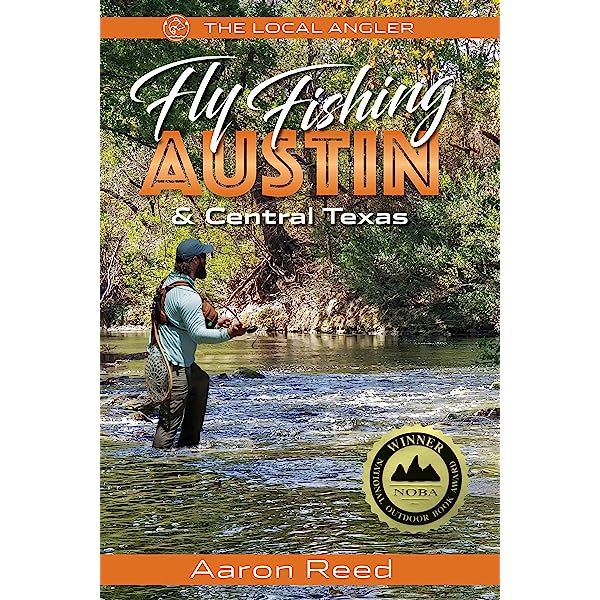Fly fishing is a specialized technique that uses lightweight lures and a specific casting method, while regular fishing involves the use of heavier lures and various casting techniques. Fly fishing is a unique method of angling that utilizes lightweight artificial flies as lures, which are typically made of feathers, fur, and other natural materials.
This form of fishing requires the angler to use specialized fly rods, reels, and fly lines to cast the flies onto the water’s surface. On the other hand, regular fishing encompasses a broader range of techniques and equipment. It involves using heavier lures, such as jigs, spoons, or bait, and employing various casting methods to cast the line into the water.
Both types of fishing have their own appeal and are popular among fishing enthusiasts worldwide.

Credit: badgerflyfishers.org
Understanding The Basics Of Fly Fishing
What Is Fly Fishing?
Fly fishing is a unique and captivating angling technique that has gained popularity over the years. Unlike regular fishing, which involves casting heavy lures or bait using spinning or baitcasting gear, fly fishing relies on the use of artificial flies made from various materials such as feathers, fur, and synthetic materials.
These lightweight flies are delicately presented on the water surface to imitate the natural prey of fish.
The History And Origins Of Fly Fishing
Fly fishing has a rich history that dates back centuries. It is believed to have originated in ancient rome, where anglers used a kind of fly made from wool and feathers. Over time, the technique spread across europe and gained prominence during the 19th century.
Early fly fishing enthusiasts, such as charles cotton and dame juliana berners, played significant roles in developing and popularizing the sport. Today, fly fishing is enjoyed by millions of anglers worldwide.
How Does Fly Fishing Differ From Regular Fishing?
Fly fishing differs from regular fishing in several ways:
- Casting technique: Fly fishing involves a unique casting technique known as fly casting. Anglers use a specialized fly rod to cast a weighted fly line. Unlike regular fishing, where the weight of the lure or bait carries the line, fly fishing relies on the weight of the line itself.
- Fly presentation: In fly fishing, the main objective is to present the artificial fly naturally on the water’s surface or below it. Anglers use various techniques, such as dry fly fishing, nymph fishing, and streamer fishing, to imitate the behavior of insects, baitfish, or other prey.
- Target species: While regular fishing can be used to target various species, fly fishing is particularly effective for catching trout, salmon, bass, and other freshwater fish known to feed on insects. Fly fishing allows anglers to mimic the exact size, shape, and movement of the natural prey, increasing their chances of success.
The Equipment And Gear Needed For Fly Fishing
To engage in fly fishing, you’ll need a specific set of equipment and gear:
- Fly rod: A specialized fly rod designed for fly fishing. They come in various lengths, weights, and actions, depending on the target species and fishing conditions.
- Fly reel: A fly reel designed to hold the fly line and provide drag when fighting fish. It is an essential component that balances the fly rod and assists in landing fish.
- Fly line: The fly line is a crucial part of fly fishing. It is typically thicker and heavier than regular fishing line, providing the weight needed to cast the fly.
- Leaders and tippets: Leaders and tippets are transparent monofilament or fluorocarbon lines that connect the fly line to the fly. They taper down in size for a more delicate presentation.
- Flies: The artificial flies used in fly fishing come in various patterns, imitating insects, baitfish, and other aquatic creatures. There is a wide range of flies available, and the selection depends on the target species and fishing conditions.
The Different Types Of Flies Used In Fly Fishing
Fly fishing relies on using different types of flies to imitate the natural prey of fish. Here are some common types of flies:
- Dry flies: These flies imitate insects that float on the water’s surface. They are designed to resemble adult insects, and anglers must present them delicately to mimic a natural resting or hatching insect.
- Nymphs: Nymph flies imitate immature aquatic insects, such as mayfly larvae or caddisfly pupae. They are fished underwater and can be attached to a dropper rig for increased effectiveness.
- Streamers: Streamer flies imitate small fish or other creatures that fish feed on. They are typically larger and more colorful than other flies, designed to provoke an aggressive response from predatory fish.
- Wet flies: Wet flies are versatile flies that imitate various stages of aquatic insects. They can be fished below the water’s surface, either actively or with a passive swinging motion.
- Emergers: Emerger flies imitate insects transitioning from their nymph stage to adulthood. They are designed to sit half-submerged in the water, attracting fish during the emergence process.
Fly fishing offers a unique angling experience, requiring skill, technique, and knowledge of the natural environment. Understanding the basics of fly fishing, including its history, techniques, and equipment, allows anglers to immerse themselves in this fascinating sport. So, grab your fly rod, tie on a fly, and embark on a rewarding fly fishing adventure.
Exploring The Art Of Regular Fishing
Regular fishing, also known as traditional or conventional fishing, is a popular recreational activity enjoyed by people of all ages around the world. While it may not have the same mystique as fly fishing, regular fishing has its own unique charm and artistry.
In this section, we will delve into the world of regular fishing, exploring the techniques, methods, equipment, and environments that make it such a beloved pastime.
What Is Regular Fishing?
Regular fishing involves the use of a fishing rod, reel, and various bait or lures to catch fish. Unlike fly fishing, which incorporates the weight of the fly line to cast the lure, regular fishing relies on the weight of the lure itself to be cast.
It can be done from the shore, a pier, a boat, or even through ice holes in frozen lakes. It offers a wide range of fishing opportunities, from freshwater lakes and rivers to saltwater oceans.
The Different Techniques And Methods Used In Regular Fishing:
- Casting: This is the most common technique used in regular fishing, where the angler casts the bait or lure into the water, allowing it to sink to the desired depth before reeling it in.
- Trolling: This method involves dragging bait or lures behind a moving boat, enticing fish to strike as they swim by.
- Bottom fishing: As the name suggests, this technique involves dropping the bait or lure to the bottom of the water body and waiting for fish to bite.
Understanding The Importance Of Bait And Lures In Regular Fishing:
- Live bait: Using live bait like worms, minnows, or shrimp can be highly effective in enticing fish to bite. The natural movement and scent of live bait can be irresistible to many species.
- Artificial lures: These come in various sizes, shapes, colors, and designs, mimicking the appearance and behavior of natural prey. Popular types of artificial lures include crankbaits, spinners, jigs, and soft plastics.
Popular Types Of Fishing Rods And Reels For Regular Fishing:
- Spinning rods and reels: These are versatile and easy to use, making them ideal for beginners. They feature an open-faced reel mounted on the underside of the rod.
- Baitcasting rods and reels: These offer more control and accuracy, making them popular among experienced anglers. The reel is mounted on top of the rod, and they are often used for larger fish species.
- Fly fishing rods and reels (distinct from regular fishing): While not considered regular fishing, fly fishing utilizes specialized rods and reels designed for casting lightweight flies rather than heavy lures.
Differences In Fishing Locations And Environments For Regular Fishing:
- Freshwater fishing: This includes lakes, rivers, ponds, and streams, offering a diverse range of fish species to target. Each freshwater environment presents its own challenges and opportunities.
- Saltwater fishing: From the vast oceans to coastal bays, saltwater fishing provides an exhilarating experience. It offers the chance to catch a wide variety of saltwater fish, including game fish like marlin, tuna, and tarpon.
Regular fishing is a timeless art that captures the hearts of fishing enthusiasts worldwide. Whether you’re casting your line into a serene lake or battling the waves in the open ocean, regular fishing brings joy, relaxation, and the thrill of the unknown.
So grab your rod, choose your bait, and immerse yourself in the captivating world of regular fishing.
Comparing Fly Fishing And Regular Fishing
Fly fishing and regular fishing are two popular types of angling that offer unique experiences for fishing enthusiasts. While both involve the art of catching fish, there are several key differences between the two techniques. In this section, we will explore the primary differences in casting techniques, the impact of water conditions, target fish species, difficulty levels, and overall experience and enjoyment of fly fishing and regular fishing.
The Primary Differences In Casting Techniques Between Fly Fishing And Regular Fishing:
- Fly fishing involves a specialized casting technique where the angler uses a weighted fly line to propel a lightweight artificial fly. The fly line is cast in a fluid motion, mimicking the movement of an insect on the water surface.
- Regular fishing, on the other hand, generally uses bait or lures that are cast using a spinning rod or a baitcasting reel. The technique involves casting the line out and then reeling it back in to attract fish.
The Impact Of Water Conditions On Fly Fishing And Regular Fishing:
- Fly fishing is particularly suited for rivers, streams, and lakes with clear water and moderate to slow currents. This technique relies on the angler’s ability to present the fly accurately and delicately to the fish, requiring relatively calm and clear water conditions.
- Regular fishing is versatile and can be practiced in a variety of water conditions, including fast-flowing rivers, murky lakes, and even in the ocean. The diverse range of baits and lures used in regular fishing allows anglers to adapt to different water conditions.
Understanding The Target Fish Species For Fly Fishing And Regular Fishing:
- Fly fishing primarily targets freshwater fish species such as trout, salmon, and bass. The lightweight flies used in fly fishing are designed to imitate the natural food sources of these fish, requiring a stealthy approach to entice strikes.
- Regular fishing, on the other hand, can target a wide range of fish species, including freshwater and saltwater fish. Anglers can choose from various bait and lure options that match the preferences of the target species, enabling them to adapt their approach accordingly.
Evaluating The Difficulty Levels Of Fly Fishing Versus Regular Fishing:
- Fly fishing is often considered more challenging than regular fishing due to the level of skill required in casting and presentation. The precise casting technique and delicate presentation make it a technique that requires practice and finesse.
- Regular fishing, while still requiring skill, can be more accessible for beginners. The casting technique is generally easier to master, and anglers have a wider range of bait and lure options to attract fish.
Considering The Overall Experience And Enjoyment Of Fly Fishing Versus Regular Fishing:
- Fly fishing enthusiasts often derive immense satisfaction from the artistry and challenge of the sport. The tranquility of the surroundings, the precision of the casting, and the connection with nature make for a unique and immersive experience.
- Regular fishing offers its own kind of enjoyment, with the thrill of the chase, the excitement of a bite, and the camaraderie shared among fellow anglers. It allows for a more relaxed and casual approach, making it ideal for those seeking a leisurely fishing experience.
While both fly fishing and regular fishing share the common goal of catching fish, they involve distinct casting techniques, respond to different water conditions, target different fish species, offer different difficulty levels, and provide unique overall experiences and enjoyment. Whether one chooses fly fishing or regular fishing depends on personal preferences, skill level, and the desired fishing experience.
Conclusion
Both fly fishing and regular fishing have their unique characteristics and appeal. While regular fishing is a traditional method that involves casting a lure or bait to attract fish, fly fishing requires a more specialized approach using artificial flies to mimic natural prey.
Fly fishing is often considered a more challenging and skillful technique, requiring finesse and precision. Both forms of fishing offer opportunities for relaxation, connection with nature, and the thrill of the catch. Whether you prefer the peacefulness of casting a line on a quiet lake or the excitement of battling a trout in a fast-flowing river, fishing provides a rewarding experience for all.
Ultimately, the choice between fly fishing and regular fishing depends on personal preferences, location, and the type of fish you wish to target. Whichever method you choose, make sure to respect the environment, follow local fishing regulations, and enjoy the journey.
Happy fishing!





